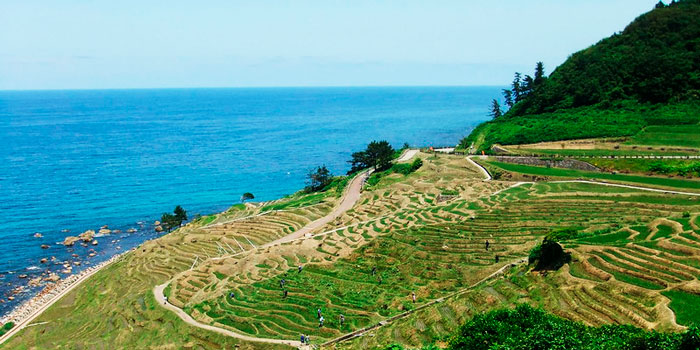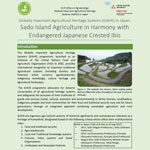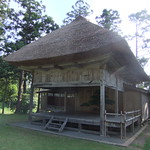Sado’s Satoyama in Harmony with Japanese Crested Ibis, Japan
GIAHS since 2011

Traversed by two mountain ranges with a broad plain in the middle, Sado Island is characterized by a variety of landforms and altitudes, which have been ingeniously harnessed to create the satoyama landscape, a dynamic mosaic of various socio-ecological systems comprising secondary woodlands, plantations, grasslands, paddy fields, wetlands, irrigation ponds and canals. These exist in close proximity and interdependence with the marine-coastal ecosystems of satoumi landscapes, comprised of seashore, rocky shore, tidal flats and seaweed/eelgrass beds.
With their ecosystem complexity, the satoyama and the satoumi landscapes in Sado Island harbor a variety of agricultural biodiversity, such as rice, beans, vegetables, potatoes, soba, fruit, grown in paddy fields and other fields, livestock, wild plants and mushrooms in forests, and many seafood in the coastal areas. The satoyama in Sado was also the last habitat of the wild Japanese crested ibis, a cul-turally valued bird in Japan that feeds on paddy fields and roost on the tall trees.
After a period of systematic promotion of conventional agriculture in Sado similar to the rest of Japan, the island is witnessing a revival of traditional practices, catalyzed by its efforts to reintroduce the crested ibis to the wild. Traditional ecological knowledge associated with satoyama is being combined with applications of modern technology and governmental policy to restore the mosaic of ecosystems on which the ibis depends for its survival while promoting environmentally-sound agricultural practices.
Brochure
Sado Island Agriculture in Harmony with Endangered Japanese Crested Ibis
One agroecology-based GIAHS is “Sado’s Satoyama in Harmony with the Japanese Crested Ibis” located in Sado City, Niigata Prefecture, Japan. An island city of 855 km2 populated with 56,831 people (Aug 2017), out of which 4,377 farmers operate over a total farming area of 7942 hectares (Agriculture Census, 2015), Sado was designated by the FAO as one of Japan’s first GIAHS in June 2011.



